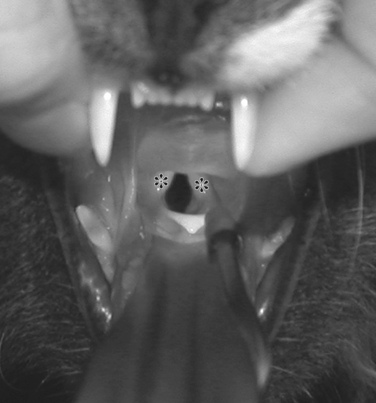L
Laryngeal, Pharyngeal, and Oral Examination
OVERVIEW AND GOAL
Complete examination of oral cavity, oropharynx, larynx, and part of the nasopharynx
EQUIPMENT, ANESTHESIA
OROPHARYNGEAL AND NASOPHARYNGEAL EXAMINATION:
FINE-NEEDLE ASPIRATION/BIOPSIES:
PREPARATION: IMPORTANT CHECKPOINTS
PROCEDURE
 LARYNGEAL, PHARYNGEAL, AND ORAL EXAMINATION Typical appearance of glottis of a healthy, anesthetized cat. Tongue is depressed with a laryngoscope, revealing epiglottis ventrally (tip appears as a white triangle in center of image), soft palate dorsally, and arytenoid cartilages laterally (asterisks). Slightly deeper and ventral to arytenoid cartilages, vocal cords are seen (slight obliquity; animal’s left vocal cord is seen more clearly here than right one).
LARYNGEAL, PHARYNGEAL, AND ORAL EXAMINATION Typical appearance of glottis of a healthy, anesthetized cat. Tongue is depressed with a laryngoscope, revealing epiglottis ventrally (tip appears as a white triangle in center of image), soft palate dorsally, and arytenoid cartilages laterally (asterisks). Slightly deeper and ventral to arytenoid cartilages, vocal cords are seen (slight obliquity; animal’s left vocal cord is seen more clearly here than right one).ALTERNATIVES AND THEIR RELATIVE MERITS
Gross ME, et al. A comparison of thiopental, propofol, and diazepam-ketamine anesthesia for evaluation of laryngeal function in dogs premedicated with butorphanol-glycopyrrolate. J Am Anim Hosp Assoc. 2002;38:503.
Monnet E. Laryngeal paralysis and devocalization. In: Slatter D, editor. Textbook of small animal surgery. ed 3. Philadelphia: WB Saunders; 2003:837-845.
Radlinsky MG, Mason DE, Hodgson D. Transnasal laryngoscopy for the diagnosis of laryngeal paralysis in dogs. J Am Anim Hosp Assoc. 2004;40:211.
Radlinsky MG, et al. Comparison of three clinical techniques for the diagnosis of laryngeal paralysis in dogs. Vet Surg. 2009;38:434-438.
Rudorf H, Barr FJ, Lane GJ. The role of ultrasound in the assessment of laryngeal paralysis in the dog. Vet Radiol Ultrasound. 2001;42(4):338-343.
Tobias KM, Jackson AM, Harvey RC. Effects of doxapram HCl on laryngeal function of normal dogs and dogs with naturally occurring laryngeal paralysis. Vet Anesth Analg. 2004;31(4):258.
Tobias KM, et al. Effects of various anesthetic agents on laryngeal motion during laryngoscopy in normal dogs. Vet Surg. 2004;33(2):102.



